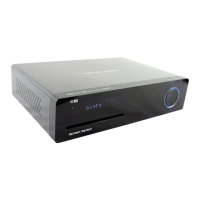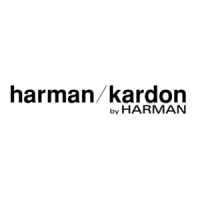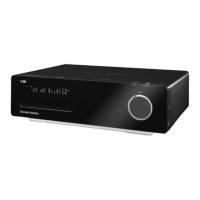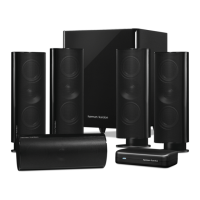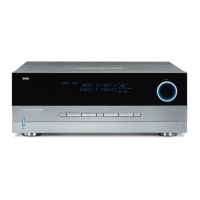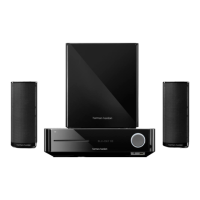TV MENU, AUX MENU, DIGITAL IN MENU
30 TV MENU, AUX MENU, DIGITAL IN MENU
3. Press the Enter Button P to make that input the
new default when the digital input is selected.
Audio: This line lets you select the surround mode that
is used when the Digital Input is selected. To change
the default mode, follow these steps:
1. With the DIGITAL IN menu on your
video display, press the
M
/
N
/
K
/
L
Navigation
Buttons A as needed so that the current sur-
round mode to the right of the Audio line at the
top of the menu screen is highlighted.
2. Press the Enter Button P, and within five sec-
onds press the
M
/
N
Navigation Buttons A so
that the desired surround mode is highlighted. Note
that “Original” will pass through the digital mode that
is output from the source device without any change
by the HS 100. In addition, the HS 100 always
selects Dolby Digital or DTS when either of those
two types of digital audio data is detected.
3. Press the Enter Button P to set that mode as
the new default when the Digital input is selected.
Level Adjustment: This line lets you increase or
decrease the input level for the Digital input to com-
pensate for any variations that may be caused by the
source device. In most cases you will not need to
adjust this setting, but if the audio level when the Digital
input is selected appears lower or higher than other
sources, follow these steps to make an adjustment:
1. With the DIGITAL IN menu on your video
display, press the
M
/
N
/
K
/
L
Navigation
Buttons A as needed so that the current Level
Adjustment setting on the second line in the middle
portion of the video display is highlighted.
2. Press the Enter Button P and within five sec-
onds press the
M
/
N
Navigation Buttons A so
that the desired increase or decrease in the input
level is highlighted in the Options Descriptions
Line é at the very bottom of the display screen.
3. Press the Enter Button P to enter the new set-
ting to the HS 100’s memory.
Surround Modes
The HS 100 will always select Dolby Digital or DTS
when either of those two digital formats is detected
with the playback of a DVD using the HS 100’s player,
or when the Digital Input is selected. However, when
the analog inputs are in use (except the AM section of
the tuner), or when a Dolby Digital 2.0 source is in use,
you have a choice of surround modes. Following the
instructions above with each input, the following sur-
round modes may be available:
Dolby Digital: Available only when digital sources
encoded with a Dolby Digital data stream are in use,
Dolby Digital delivers up to five separate main audio
channels along with a dedicated low-frequency effects
channel.
DTS: Available only when digital sources encoded with
a DTS data stream are in use, DTS delivers up to five
separate main audio channels along with a dedicated
low-frequency effects channel.
Dolby Pro Logic II Movie: Shown in the Options
Descriptions Line é as “Dolby PLII
Movie”, this mode creates or decodes full-range,
discrete left, center, right, right surround and left sur-
round channels from both matrix-encoded and conven-
tional two-channel stereo sources. It is optimized for
movie soundtracks.
Dolby Pro Logic II Music: Shown in the Options
Descriptions Line é as “Dolby PLII
Music”, this mode creates or decodes full-range,
discrete left, center, right, right surround and left sur-
round channels from both matrix-encoded and conven-
tional two-channel stereo sources. It is optimized for
music playback.
Dolby Pro Logic: Shown in the Options Descriptions
Line é as “Dolby PL Emulated”, this
mode activates the original Dolby Pro Logic decoding
for those who prefer that presentation.
Stereo: Select the Stereo mode in the Options
Descriptions Line é for traditional two-channel
playback with no multichannel surround processing.
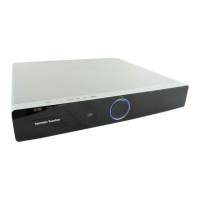
